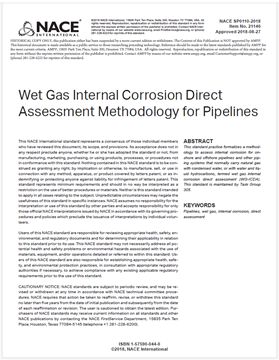Search
Products tagged with 'Downloadable'
View as
Sort by
Display
per page
SP0110-2010-SG (Chinese) Wet Gas Internal Corrosion Direct Assessment Methodology for Pipelines
Product Number:
21159-SG
ISBN:
1-57590-241-9
Publication Date:
2010
$179.00
SP0110-2018, Wet Gas Internal Corrosion Direct Assessment Methodology for Pipelines
Product Number:
21146-SG
Publication Date:
2018
$179.00
SP0111-2019, “Coating Technical File in Accordance with the IMO Performance Standard for Protective Coatings”
Product Number:
21153-SG
ISBN:
1-57590-245-1
Publication Date:
2019
$109.00
SP0114-2014-SG, "Refinery Injection and Process Mix Points"
Product Number:
21175-SG
ISBN:
1-57590-284-2
Publication Date:
2014
$109.00
SP0169-2013-SG, "Control de la corrosión externa en sistemas de tuberías metálicas enterradas o sumergidas"
Product Number:
21181-SG
ISBN:
1-57590-035-1
Publication Date:
2013
$179.00
SP0169-HD2007-SG (formerly RP0169), "Control of External Corrosion on Underground or Submerged Metallic Piping Systems"
Product Number:
21173-SG
ISBN:
1-57590-035-1
Publication Date:
2007
$179.00
SP0170-2012 - Protection of Austenitic Stainless Steels and Other Austenitic Alloys from Polythionic Acid Stress Corrosion Cracking during Shutdown of Refinery Equipment
Product Number:
21002-HD2012-SG
ISBN:
1-57590-039-4
Publication Date:
2012
$179.00
SP0170-2018-SG Protection of Austenitic Stainless Steels and Other Austenitic Alloys from Polythionic Acid Stress Corrosion Cracking During a Shutdown of Refinery Equipment
Product Number:
21002-SG
ISBN:
1-57590-039-4
Publication Date:
2018
$109.00
SP0176-2007, Corrosion Control of Submerged Areas of Permanently Installed Steel Offshore Structures Associated with Petroleum Production
Product Number:
21018-SG
Publication Date:
2007
$179.00
SP0177-2007-SG (Chinese) Mitigation of Alternating Current and Lightning Effects on Metallic Structures and Corrosion Control Systems
Product Number:
21160-SG
ISBN:
1-57590-116-1
Publication Date:
2007
$179.00
SP0177-2014 (formerly RP0177), Mitigation of Alternating Current and Lightning Effects on Metallic Structures and Corrosion Control Systems
Product Number:
21021-SG
ISBN:
1-57590-116-1
Publication Date:
2014
$179.00
SP0181-2006 (formerly RP0181), Liquid-Applied Internal Protective Coatings for Oilfield Production Equipment
Product Number:
21025-SG
ISBN:
1-57590-205-2
Publication Date:
2006
$179.00












